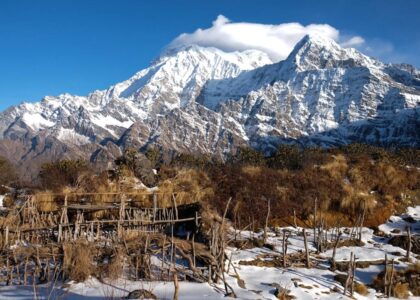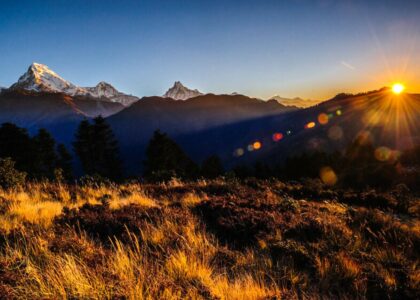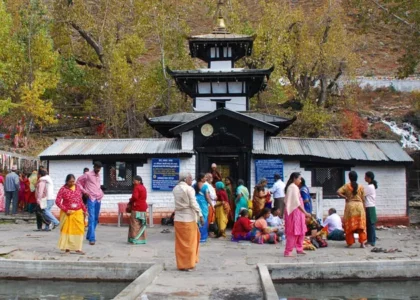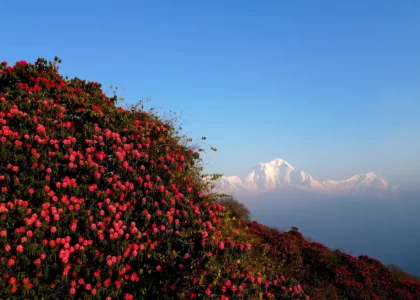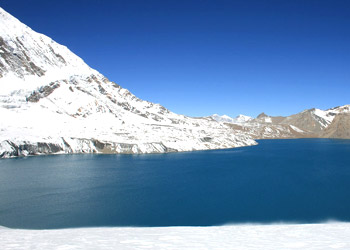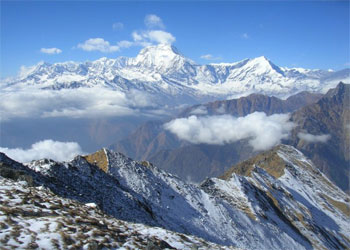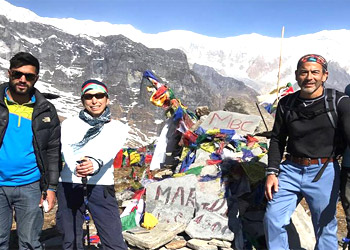Annapurna Region Trek
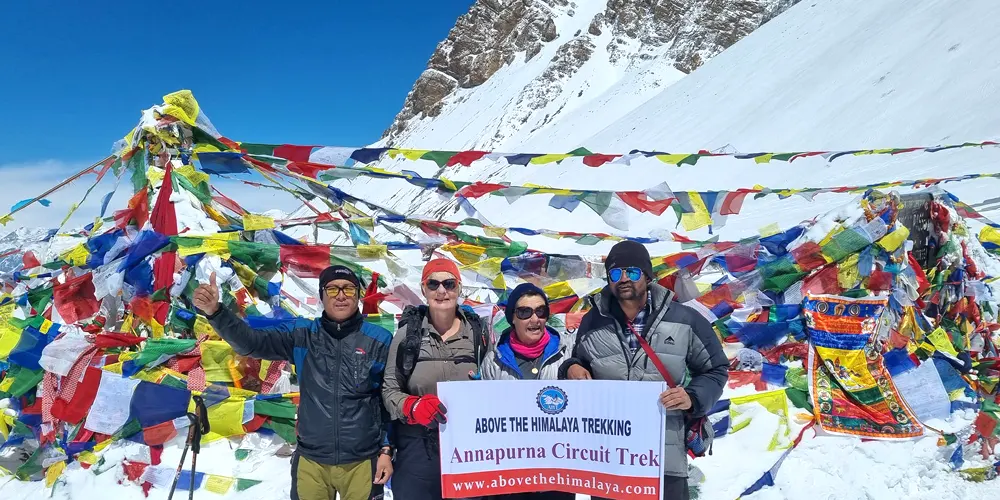
Annapurna region Trek is the world’s most beautiful destination—perfect for mountain and nature lovers. It was the first mountain to be successfully climbed among the 14 peaks. A French excursion led by Maurice Herzog made history by climbing Annapurna on June 3, 1950.
Before that, different people had made many attempts. During the Annapurna trek, you can see the majestic view of the Annapurna base camp trek region’s cliffs. The Annapurna regions have the best flora and fauna. The stunning mountains surround the area.
The Annapurna trek regions are a mix of snow-capped peaks and crystal-clear blue lakes. They also have chaotic rivers with deep gorges. Along the trail, we will visit Sacred Hindu temples and Buddhist monasteries. The natural hot springs in Myagdi Tatopani are a bonus. Many ethnic groups live in picturesque vintage villages.
Annapurna region trek is the world’s best trail.
Annapurna’s natural environment is diverse, from 800m to 5400m. The climate starts from sub-tropical forests. The forests have oak, bamboo, pine, sandalwood, magnolia, juniper, and rhododendrons.
From the high alpine meadows and windswept in the south, barren plateaus are up the north. During your Annapurna region trek, many colorful butterflies are along the way. We can watch the striking birds, Blue Sheep, Himalayan Tahr, bear, and leopard. We can also see monkeys and much more unique local fauna.
Most of it starts from the well-known city of Pokhara, described as ‘the land of the dreams.’ You will experience a beautiful, traditional Nepali lifestyle and culture. Nepal has different ethnic groups. Some of them are Gurung, Magar, Thakali, and Manangi. They are famous for their hospitality, friendliness, and great sense of humor.
Annapurna Region Trekking
The main highlights of trekking in the Annapurna region are the mountain views of Annapurna I (8,091m), II, III, IV, and Annapurna South. Mt. Dhaulagiri (8,167 m); Mt. Manaslu (8,176m); Mt. Nilgiri. Mt. Machhapuchhre (Fishtail); Gangapurna and several more.
We will trek through the deepest gorge in the world, Kali Gandaki, and also the highest lake (Tilicho Lake). Enjoy the majestic sunshine view from the Ghorepani Poon Hill view spot. We can enjoy the natural hot springs at Tatopani. The opinions of the Muktinath Temple and the Annapurna Base Camp are the best.
The best route
Annapurna Base Camp is more popular these days on the Annapurna region trek. It is easy to reach and has various short or long-route options. It is one of the super exciting and perfect tours for adventure lovers. It is also the fastest way to view Mt. Annapurna and its range from the Annapurna Base camp (4,130m).
The sparkling mountains region and its stunning views are worth watching. Nepal is one of the best adventure treks in the Annapurna region. Nepal is on the top list of many travelers after the Everest Base Camp trek. It covers beautiful landscapes. It provides you with the closest view of the mountains.
It is the best place to see the best mountains, such as Mt. Fishtail, Tent Peak, the Manaslu range, the Lamjung Himal range, and Mt. Dhaulagiri. Those with a limited time who want to explore the Annapurna region can opt for a helicopter day trip. The helicopter tour gives views of dynamic landscapes. You can also see the Lush and Primitive valleys of the Annapurna region trekking.
Best Time for the Annapurna region trek
There is no restriction on traveling to the Annapurna region trek annually. The two-week Ghandruk trek is an easy and small tour. We can do it all year round. But for the long and challenging hike, Spring and Autumn are the most important.
We need to be careful during the rainy season. Heavy rain and landslides sometimes occur, so we advise only a 2-3 day trip. Autumn and Spring are the best seasons for the Annapurna region trek. Winter is also suitable for snow lovers. It is the cold season and the season when snowfall occurs.
But, in winter, snow covers the trekking trails. The chilled weather at the lower altitude makes coping with the conditions harsh. Hence, the autumn and spring seasons ( March, April, and May, whereas September, October, and November) are the best months for trekking in the Annapurna Region.
Trek in Monsoon Season
If you are a challenge-taker, the autumn season will meet your adventurous trip. Usually, the Monsoon season starts in June and ends in mid-September. The average temperature during that Time remained 20-25 degrees Celsius.
The nighttime temperature stays below 10 degrees Celsius. Thus, the warm environment is always favorable for opting for the Annapurna base camp trek. There are better times to visit the Annapurna region trekking.
But, at this Time of the year, the Annapurna region trek is generally affected by monsoon rains. The warmer days may sometimes encounter rainfall. It makes it difficult to travel. This season faces sponge, also known as leech season.
Thus, wearing full socks and boots is advisable to avoid leech attacks. Also, when the rain stops, you can see the surroundings. Green vegetation and other creatures benefit from this season and look astounding.
In this season, you get dust-free surroundings. Off-season discounts are the significant advantages of traveling in this season. Annapurna region has a rain shadow area. It is for an optional Annapurna region trekking trail. Thus, you can opt for this trail to avoid the rain effect.
Winter Season
The other challenging season is trekking in the Annapurna region in winter. Winter in Nepal starts in December and ends in mid-February. This Time of year is the most adventurous and also the coldest.
A warm jacket, extra clothes, and hot drinks are always good to avoid cold. You may also encounter snow in most of the mountain region. Thick snow covers the surroundings. The mountains are super beautiful now.
Remember that night temperatures may go below the freezing point on the Annapurna region trek. But you can have a heavy discount on food and accommodation. Plus, crowded, accessible trails are exhilarating to enjoy. This season is not the best Time to trek the above 4000m Annapurna region.
Annapurna region trekking in Nepal
Annapurna region trekking in Nepal has lots to offer. You can see various farmlands and pasturelands. You can also see typical village settlements along the way to the trekking. You also cannot avoid the beauty of vibrant flora and fauna that have mesmerizing aurora.
The lush green forests always sparkle, welcoming tourists to its warm lands. They shower enormous beauty so that one will forget all their life chaos. Apart from this, these creatures flash differently in different seasons. So it does not matter which season you visit the Annapurna region. It always offers beautiful creatures and treasured moments.
Most parts of the Annapurna region trek trail are flat along the way. The path gains a gradual increase in altitude. All in all, you will have moderate difficulty in this trekking journey. The best part is that you will always enjoy the trekking travel in Nepal.
The side views will tempt you and motivate you all along the way. Thus, enjoying and capturing the side views could be your primary job, and I am sure you will love it.
You will stay at a local tea house.
Another good part of the Annapurna region trekking is you will get lodges and teahouses. It will be pretty fun. Not only this, you will also get to experience different cultures and traditions.
These teahouses and lodges provide you with the best services.
They offer a warm environment so that you can enjoy your quality time there. Avoid worrying about the food and accommodation. These teahouses and lodges remain open throughout the year.
Annapurna Base Camp is one of the best adventure treks you could choose in the Annapurna region trek. The Trek combines many landscapes and gives you the closest view of higher peaks.
Altitude sickness Problem
Annapurna is the eighth-highest mountain peak in the world. The altitude to the Annapurna trekking region is 5416 m sea level. You may get the symptoms of altitude sickness. The symptoms of altitude sickness are headache, fatigue, nausea, and diarrhea. It also causes a lack of appetite.
There are not any hospitals on the route. You should inform your friend and the guide if you feel like you’re having altitude sickness. With the increase in altitude, you will face variations in weather and temperature.
The air also gets thinner as you move up. Altitude sickness is a common problem at high altitudes in the Annapurna region. To avoid it, you must drink lots of water. Do not take sleeping pills or consume alcohol, as these may worsen the condition.
Be Well prepared and get some exercise.
Based on the experience you are seeking, you can choose accessible and challenging routes in this Annapurna region trek. It is the complete package of sheer beauty. Beautiful typical village settlements, magical massive mountains, and hot springs encompass the area. The trails of the Annapurna region are stepping up and down.
We advise you to get some training and preparation for trekking in the Annapurna region. Trekking in this region may be grueling for novice travelers. The stunning beauty of jaw-dropping mountains will make you speechless.
You know what is challenging: standing at the base of the world’s most dangerous peak. Trekking around the famous Annapurna sanctuary is fabulous. You need to have a minimum of 7 days to complete this journey. With the right gear and necessary equipment, you can achieve this journey.
Guide and porter hiring for Annapurna region trek
It would help if you had a guide to make your Annapurna region trekking easier and more comfortable. The guide helps show the way and gives the information about the place. It would be best if you had a guide to carry your stuff.
Most people hire a guide but not a porter, whereas some hire a porter but not a guide. But if you hire a guide, you will always be safe, and you can get lots of information regarding those places. Hiring a porter in the Annapurna region trek is very helpful for you as the roads are pretty rough. So, hiring a guide and porter makes your hike more enjoyable and accessible.
Clothing tips
The Annapurna region trek is icy. You will need to pack your warm clothes.
Your Annapurna region trek can be easy with the right gear and equipment. Proper gear can make any hike less complicated and more enjoyable. The Annapurna Sanctuary trek falls in the rain-shadow summer/ monsoon area. It does not affect your Annapurna region trek, but you will need proper clothing and equipment to make your walks easier. You will need a pair of trekking shoes and a waterproof and windproof jacket.
Gear Details
- You must carry a sleeping bag, which helps trekking on cold nights at higher altitudes in the Annapurna region.
- Always carry a medical kit comprising essential medicines like paracetamol, bandages, gloves, tape, etc., which you may need at any time.
- You can also carry purifying tablets and have clean water anytime you need.
- It would help if you took warm and good clothes with you as you will be walking at a high altitude and the weather may be freezing.
- For your screen protection, you can carry sunglasses, a sunhat, and sunburn cream with you.
- You have to have enough cash and manage your budget wisely.
- You must buy trekking boots because hiking in other shoes hurts your feet, but if you walk in your trekking shoes, you will not damage your feet, and they will make you feel comfortable.
- Gain as much information about the Trek as you can have. It will help with your preparation.
- You can choose the best weather conditions for a perfect and comfortable trek for beginners and anyone who wants to enjoy a comfortable Annapurna region trek.
- It would help if you took the necessary permit for the Annapurna region trek.
- Don’t walk alone. Stay with the group; trekking with a guide is better.
- Wearing a knee cap will help reduce knee pain, and you can trek comfortably in the Annapurna region.
- Prepare yourself before training by doing yoga, exercise, and swimming.
- Be mentally and physically prepared before trekking in the Annapurna region. It will help to reduce altitude sickness.
The most difficult Annapurna region trekking
Dhaulagiri Trek
This Trek is the challenging and strenuous adventurous Annapurna region trekking package. It offers a beautiful view of Dhaulagiri I, II, III, IV& V. Mount Dhaulagiri I is the seventh-highest peak in the world at 8167m above sea level.
This Dhaulagiri round trekking follows the glaciers and crosses high snowcapped passes. It is a challenge suited only to fit individuals wishing to go on the remote. This trekking in Nepal is in the lap of Mt. Dhaulagiri and Mt. Annapurna giants. Dhaulagiri region is also a land of dramatic contrast.
The main appeal of this Annapurna region trek is the scenic Himalayan view of the snowcapped peaks. It includes, Dhaulagiri, Tukuche Peak, Nilgiri, Annapurna, and Machhapuchhare, etc.
You can also see a spectacular view of Dhaulagiri, Thorong Peak, Annapurna, and Kali Gandaki River.
During the Dhaulagiri trekking, one can see the world’s deepest gorge. The Trek goes through significant, challenging mountain passes. This remote Dhaulagiri Annapurna trekking region offers impressive natural scenery. It also provides an evergreen forest blossoming with rhododendrons.
The warm-hearted native people add to the natural beauty of the place. They have their heady mixture of a unique culture. The drive to Beni from Kathmandu or Pokhara takes you to the start point of this complex Annapurna region trekking route.
From Beni, we set out on foot. We will enjoy the cultivated fields, forests, and villages during the drive. Various ethnic groups, like Gurung, Chettri, and Magar, live there. After a few days of the trip, we will reach the Italian Base Camp.
We can see the breathtaking views of Dhaulagiri I, II, III, IV, and V. Furthermore, you will have rest days to acclimatize to the altitude. It helps you to be ready for the highest level of Annapurna trekking. After rest, we will trek into the beautiful forests. It provides closer views of the panorama of the mountains. The path will lead to Upper Vungini, which is the Italian Basecamp.
Dhaulagiri trek goes through a hidden snow valley.
We pass through an ever-changing landscape with numerous picturesque villages before reaching Dhaulagiri Base Camp. In the Annapurna trekking region, you can see semi-wild yak herds and mountain sheep. You can also see the elusive snow leopard and the Kali Gandaki River, the world’s deepest gorge.
The villages and the valleys are particularly memorable, with its charming inhabitants. Subsequently, we descend to Marpha. It is a famous city in the Mustang district. It lies between the majestic mountains of Annapurna, Nilgiri, and Machhapuchhare.
It is an overwhelming adventure of the remote west of Dhaulagiri. It is the main popular Trans-Himalayan Salt Trade route. It goes through the world’s deepest gorge and Kali Gandak in the Annapurna region trek. In the valley, you will get an opportunity to explore the snow-capped Himalayas.
They are lying around rocky hills and stunning landscapes. The area also has yak pastures and a thick forest full of birds, animals, and more. You can dig into the Gurung and Magar peoples’ lifestyle and culture on the Dhaulagiri trek trail.
Besides that, you can see wild animals like Himalayan Thar, Red Panda, Leopards, and Musk deer, as well as different species of birds. Furthermore, this is off the beaten path and incorporates the best of what Nepal offers.
Annapurna Circuit and Annapurna base camp trek
You can take two famous routes if you have longer holidays in Nepal. You can go for the Annapurna round and base camp together. It is the classical and ultimate trekking in the Annapurna Region. It is the most popular adventurous circuit for long-walking trekkers.
This trekking is a vast, awe-inspiring amphitheater. A multitude of snow-packed Himalayan peaks surrounds it. Annapurna base camp with Annapurna circuit trail follows holy Buddhist and Hindu Shrines in Muktinath. You pass through every type of vegetation zone. You can see lush sub-tropical to harsh semi-desert in Jomsom.
During this Annapurna trekking, we will explore the picturesque Manang and Mustang Valleys, see the magnificent Kali Gandaki and Marsyangdi Rivers, enjoy close-up views of the Himalayas, and experience varied ecosystems, green paddy fields, and oak forests.
The middle part of the Trek goes into the deepest gorge in the world. Annapurna Circuit and Annapurna base camp trekking allows you to enjoy the Himalayas. You can experience the Himalayas from different angles and perspectives. In those regions, the scale always continues.
We will trek through various landscapes, ranging from subtropical through alpine to an arid semi-desert akin to Tibet. The climax of the Trek is crossing the rugged Thorong-La pass (5416m) and Annapurna Base Camp. Thus, you can get close-up views of the giant snow peaks during this Annapurna trek.
It includes Annapurna I (8,019m.) and Annapurna III (7,555m.). Gangapurna (7,454m.), and Machhapuchhre (6,993m). You have the opportunity to experience sound hospitality. The warmth of the native residents welcomes you. The unique cultures of the Gurung, Thakalis, and Magar societies will bring rejoicing and jostle.
The less travel route of Annapurna region trekking
Panchase hill trek
This is the easy hiking route for our Annapurna region trek. It is thus suitable for all age groups and fitness levels. It is an ideal trek where all families can enjoy the experience of trekking off the beaten path. Panchase Hill provides the best views of Mount Macchapuchare, Dhaulagiri, and Annapurna.
It also offers views of the Lamjung and Manaslu ranges. Panchase Lake is on the border of three districts: Kaski, Syangja, and Parbat. The entire Panchase region is the primary source of Fewa Lake and is a holy pilgrimage site. Panchase hill trekking passes through many villages.
You will have ample Time to take photographs and interact with the local people. The highest point of this Trek is at an altitude of 2500m. Unlike most other trekking routes in Nepal, there is no worry of suffering from High Altitude Sickness.
Panchase hill treks begin on the southwest side of the beautiful city of Pokhara. You get to experience its natural beauty and panoramic views. We can participate in different topographical structures in this Annapurna trek on Panchase Hill.
It goes from subtropical valleys of rice paddies to ridges and green thickets. There is an abundance of Rhododendrons and other wildlife. Panchase Hill has religious significance as well. Panchase Hill route is abundant with an array of birds and wildlife.
We will walk through the Gurung villages. Enjoy the local cultures and traditions. The terrain varies from subtropical valleys of banana trees and rice paddies. We pass the rhododendron forest. From Bhadure, we drop to Sarangkot.
It offers splendid Himalayan sights such as Annapurna, Dhaulagiri, and others. We can follow different routes to visit Panchase Hill. This Annapurna trekking trail is also a new area. It is best for those looking for something different, less touristy, and easy to walk.
Siklis trek
The Annapurna Siklis trek is easy. It is a nearby route from Pokhara Valley that allows you to enjoy Nepal’s traditional culture. This Trek is beautiful, short, and easy Annapurna trekking. It gives a great introduction to the beauty of the Annapurna region.
We will enjoy the beautiful chirping sound of the birds all along the trekking route. The Trek provides fantastic views of the Annapurna Himalayan ranges, Dhaulagiri, and Mt. Manaslu. Siklis is one of the largest Gurung villages in Nepal. It offers an opportunity to learn the unique traditional culture.
It is a genuinely captivating village experience where we get to see the real rural Nepal. We will start this Annapurna trekking after driving to Bijayapur Khola from Pokhara. From this point, we will ascent to uphills through the Rice Fields and low land views.
We will walk through the villages of the Gurungs, a people of Tibetan origins. They also practiced an interesting shamanistic. While climbing up, we will pass the ridges of open pasture. We enjoy uninterrupted views of Annapurna II (7939m) and Annapurna IV (7525m).
From a marvelously scenic angle, you will witness Mt. Dhaulagiri, Lamjung Himal, Fish Tail, and other giants. The trails pass through the quiet forest, alive with bird song and a blaze of color in Spring. The view from the ridges of the endless blue foothills is breathtaking.
They roll southwards anywhere in the Kingdom. This Annapurna trekking region is best for bird lovers. It has pristine forested surroundings where different species of birds thrive.
Royal Trek
The Royal Trek is the easiest, shortest, and most inspirational route of Annapurna trekking. It is one of the famous short trekking trails. It offers good mountain views, ridge walking, forests, rice fields & different village types. It is one of the excellent treks to do.
It doesn’t require any particularly long walking days. It offers plenty of Nepalese villages and mountains. This Trek starts from Pokhara, where there are stunning mountain views. Charles Prince of Britain walked this route in 1980 with an escort of 90 guests, followers, and staff, so it gained its name as “Royal Trek.”
Annapurna Royal Trek takes you along peaceful ranges. It goes through terraced hills all around the Annapurna trekking route. You will see colorful flora and fauna painting the landscape. Eagles can be seen soaring high above. You get good mountain views, including Machhapuchhare and Annapurna.
The route here is less crowded. You get an accurate picture of unique nature, lifestyles, and ancient holy practices. This short Trek commences from Pokhara, the valley of lakes. It offers scenic views of the Annapurna Himalayas massif and the Manaslu Himal.
During this Annapurna region trekking, we will pass many small villages, terraced fields, forested ridgetops, lakes, and temples. We can also enjoy the rhododendron forests. The dazzling close-up view of the Machhapuchhare and Annapurna makes the Trek outstanding.
Furthermore, this easy Annapurna trekking begins in the Gurung village. It offers stunning views of the Machhapuchre, Annapurna, Lamjung, and Manaslu Himalayan ranges.
Jomsom Trekking
The Jomsom is the gateway of Nepal’s hidden treasure, the” Mustang” of Annapurna region trekking. The trail passes the landscapes of Mustang to reach Muktinath. It is the Hindus’ and Buddhists’ sacred pilgrimage. Jomsom Trekking offers fantastic Himalayan views and beautiful landscape trails.
It offers Kali Gandaki Valley’s famous apple garden in Marpha and Tukuche village. Jomsom Trek provides stunning views of mountains above 8000m, such as Mt. Dhaulagiri [8167m], Mt. Annapurna I [8091m], Dhaulagiri, and many more.
The trekking area is on the dry, desert-like Tibetan Plateau, with treeless, bare terrain. The landscape allows access to the high mountains of the Himalayas. You can reach there within a reasonable timeframe. You need not ascend to an adventurous attitude.
Jomsom Trekking is moderate trekking. You can take a flight from Pokhara to Jomsom or drive to Muktinath. The Jomsom trek passes the narrow Kali Gandaki valley and the deepest gorge in the world. It brings you to the base of Nilgiri and into the Mustang area.
This Annapurna Trekking route explores the sacred temple of Muktinath. The ancient Muktinath temple, a pagoda-shaped temple of Lord Bishnu, is a center for pilgrimage. It has 108 waterfalls around it.
The marvelous mountain views are breathtaking. The clouds roll in the early morning, providing an excellent environment for this Trek. One can enjoy the diverse cultures of various communities and their classic lifestyles. It genuinely gives a once-in-a-lifetime experience for trekkers and visitors.
Side trips for Annapurna region trekking
Milarepa Cave 4000m height:
The Annapurna region offers many exciting landscapes and ritual sites. Milarepa cave is on the north face of Annapurna III, at the foothill of Annapurna III. The cave’s name, Milarepa, refers to the Buddhist saint Milarepa.
People believe that Milarepa meditated in this cave. You can reach the cave after walking for three hours from Manang. During the hike, you can see beautiful scenery. We can see the Marsyangdi Valley, Chulus & Pisang peaks.
It is a very worthwhile side trip from the Bragha village in Manang. It is also a famous pilgrimage site in Manang with a fascinating backstory. Ancient ladders once accessed the cave, but they are now destroyed. However, you can still see the saint’s footprint in the carvings on the cave’s wall.
Ice Lake 4600m
We can hike to this beautiful lake while we have a rest day in Manang for the Annapurna region trekking. Ice Lake is at the connecting neck of Chulu Far East. We need to climb 1100m, which takes about 4 hours from Braga. After the hard climbing, you will get the best scenery.
It offers a stunning mountain view of Annapurna II, IV, and III. We also see a close-up view of Gangapurna, Khangsahar, Tilicho Peak, and Chulu East. The lake used to freeze during the night and morning in winter and Spring, thus calling it Ice Lake.
Gangapurna Lake 3500m
You can make This easy walking hike from Manang of our Annapurna region trekking. Gangapural Lake is at the foothill of Mt Gangapurna Glacier. This lake formed due to the meltdown of Glacier Gangapurna. To reach this place, it takes 20 minutes from Manang.
We can also see the migratory ducks swimming at the lake. The cascading Marsyangdi River flows just through the side of this lake. We can take a shorter hike above the lake, which has exciting landscapes.
Titi Lake 2550m:
The other part of the Annapurna region is the trekking region, the lower Mustang Valley. It also offers lots of things to see. Titi Lake is one of them. We can reach here after r hiking 1.5 hours uphill from Kokhethanti—the walk to Lake Traverse through pine trees forest.
When we get to the lake, we will be surprised by its beauty. We can see Mt Dhaulagiri, Tukuchey Peak, Thapa Peak, and Dhaulagiri Icefall from the lake. We discussed the possible side trips and places of interest in the Annapurna circuit above. There are still many more potential places of interest we haven’t mentioned in the above paragraph.
The Dhaulagiri Icefalls
It isn’t accessible if you want to make a side trip to the Dhaulagiri Icefalls. It takes a two-day side trip and requires good physical fitness and health conditions. This tough side trip of trekking in the Annapurna region goes right into the foot of the Dhaulagiri Icefall. It gives excellent views of Mount Dhaulagiri and the Annapurna range.
We start this side trip from the small Larjung village. We will pass by forests, green pastures, rhododendrons, and pine forests along the way. After another two hours of steep climbing, get to the icefall. While returning, it is the faster ad we can take a shortcut.
Dhumba Lake
During our Annapurna region trekking, we can make a great side trip to a beautiful Dhumba Lake from Jomsom. There is a clear-water lake at Mount Nilgiri’s base. The first part of the Trek goes to a beautiful Thini Village, and after that, it will lead you to Dhumba Lake.
Dhumba Lake is a sacred Buddhist lake; many prayer flags are here. Some locals claim to come here to pray for some sort of change in their lives for their betterment. If we walk about a 15-minute walk from the lake, there is a small stupa called Kuchup Terenga Gomba.
The lake provides the picturesque snow-clad peaks and spectacular views of the valley. Furthermore, this is a calm and pleasant place to relax and one of the worthy stopovers if you’re in Jomsom. You can see the apple orchard and mud houses of the Thini Village, which gives a peek into the Mustang culture.
It was also the old salt trade route between Tibet and Nepal. During the return trail of this Annapurna region trek, we can trek to Marpha Village. It is a famous Thakali village. You can see the apple garden everywhere here, as Marpha is the apple capital of the nation. You can try the Apply brandy. You can look at the apple and apricot industry and the local Tibetan monastery there.
How long is the Annapurna region trek?
The Annapurna region trekking has a different package, from two days to two weeks. You can make it as long as we combine the two tours. The Annapurna Circuit is a more extended version. We can make the side trip to Tilicho Lake.
The length of the Annapurna Trek depends on transportation, as the lower parts now have a road. Moreover, we can do a 2 to 15-day Trek in the Annapurna region.
Book with Confidence
- Flexible bookings and easy trip date changes
- Personalized service and customized group sizes
- Safe travels with owner-operated services and highly experienced guides
- Best price guarantee for the most value for your money
- Secure & easy online booking
 Have Questions?
Have Questions?Talk to Expert
Meet Mr. Puru Timalsena, Nepal's best trek and tour organizer, who has been working in the Himalayas for more than 15 years.
WhatsApp/Viber +977 98510 95 800
